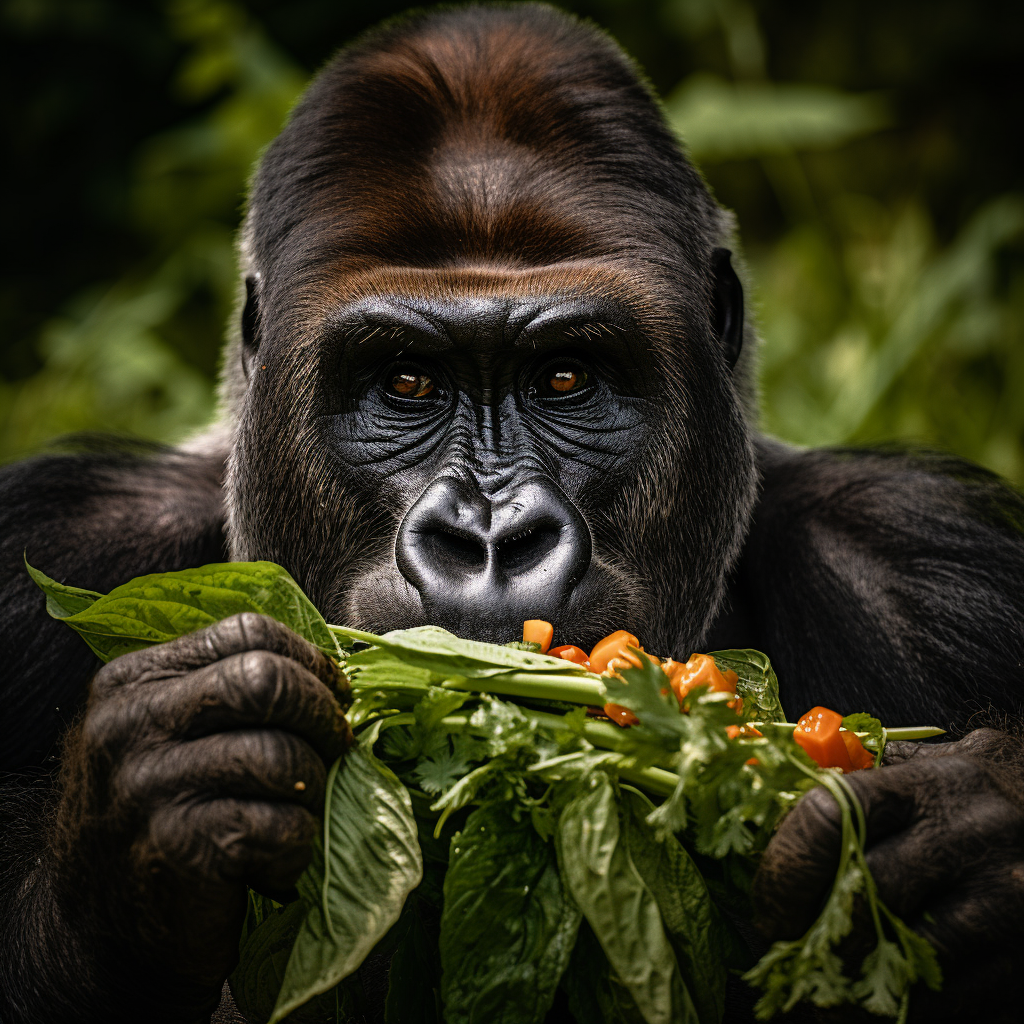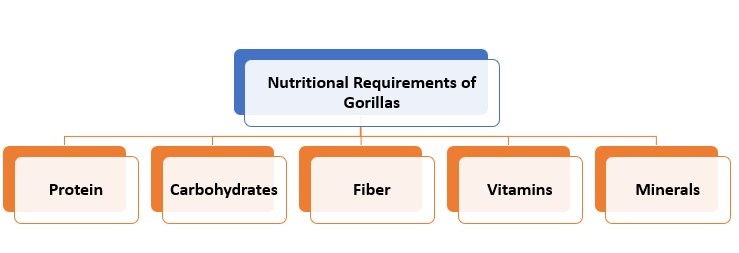
Gorillas, the largest primates on earth, have an interesting diet. Primarily herbivorous, they spend a lot of time foraging for food in their tropical forest habitats, like the rainforests of Rwanda, Uganda, and Congo.
Gorilla trekking tours offer visitors the chance to observe these majestic creatures in their natural habitat.
Key Takeaways
- Gorillas primarily eat plants, with their diet consisting mainly of leaves, stems, and shoots.
- They also consume fruits, flowers, and seeds when available.
- Gorillas are herbivores and do not eat meat or insects.
- Their diet is high in fiber and low in fat, which helps maintain their overall health.
- Gorillas spend a significant amount of time foraging for food, as they need to consume large quantities to meet their nutritional needs.
- The specific types of plants they eat vary depending on their habitat and the season.
- Gorillas have a specialized digestive system that allows them to efficiently process and extract nutrients from plant material.
- The availability of food can impact gorilla behavior and social dynamics, as they may need to travel long distances to find sufficient food sources.
- Conservation efforts are crucial to protect gorilla habitats and ensure their access to a diverse range of plant foods.
What Do Gorillas Eat?
Gorillas munch on a variety of plants found in tropical forests. They are selective foragers, breaking apart termite nests to get the termites inside. Tree bark and bananas are sometimes on the menu too.
These giant creatures, weighing up to 400 pounds, consume several kilograms of veggie-packed food every day. Leaves, stems, shoots, and other plant material make up their primary diet.
Their diet consists of leaves, stems, and bamboo shoots, plus small insects and termites found inside plants or on the ground.
Adult gorillas use their strength to break tree bark and get to termite nests. They are picky eaters, choosing bits and pieces of plants, and getting hydration from their food.
Grown gorillas can weigh up to 400 pounds and eat about 50 pounds of food each day.
However, different gorilla subspecies may have slight variations in their diets. For instance, western lowland gorillas mostly eat fruits when available.
They are mostly herbivorous but there have been rare cases of gorilla omnivory.
For instance, silverback Rafiki from Uganda’s Bwindi Impenetrable National Park was observed breaking open a termite nest with his hands to snack on the insects inside.
This unusual behavior showcases the gorillas’ immense strength and their ability to adapt to different food sources. Eating like a gorilla is a real balancing act!
Gorilla Diet in the Wild

Gorillas are mainly herbivorous animals. They select and consume various plant parts, such as leaves, stems, shoots, and even tree bark.
Some small insects and termites are also eaten to provide extra protein. But, gorillas don’t usually drink water directly from sources. Instead, they get most of their hydration from the moisture in the plants.
A silverback leads each family group in the wild. Each day, gorillas consume around 30 kg of vegetation, depending on the season.
Book a gorilla trekking tour or safari package today. You’ll be able to witness their strength and observe their unique communication methods.
Gorilla Diet in Captivity
The diet of captive gorillas is tailored to ensure their health. A typical day’s meals for them include 10 pieces of bananas in the morning and 5 in the afternoon.
Besides bananas, they also have other fruits such as apples, oranges, and grapes to provide them with essential vitamins and minerals.
For additional protein, they are sometimes given nuts or seeds. This dietary plan began in the late 20th century when researchers realized its importance for the gorilla’s well-being.
Gorillas can eat a variety of things, from bamboo shoots to banana peels, in different environments from the wilderness to the zoo!
Gorilla Diet in Different Environments
Gorillas have diverse diets, depending on their environment. In the tropical rainforest they eat a mix of fruits, leaves, stems, bark, flowers, and even insects.
In mountain areas, their main food sources are bamboo shoots, plant parts, and leaves.
Lowland gorillas eat mostly leaves and stems, with fruits when available. For gorillas in captivity, fruits, vegetables, and leafy greens make up their diet.
An adult male gorilla can weigh up to 440 pounds, which is equivalent to 6 average adults! Gorillas adjust their eating habits based on their habitat.
So whether it’s bamboo in the mountains or fruit in the tropical rainforest, they have unique dietary needs that keep them healthy.
Nutritional Requirements of Gorillas
Gorillas have special nutritional needs to support their large size and strength. They mainly eat vegetation such as fruits, leaves, stems, and shoots. Plus, they need lots of fiber from bamboo shoots and tree bark.

Nutritional Requirements of Gorillas (Table):
| Nutrient | Source | Quantity |
| Protein | Bamboo shoots, fruits | Sufficient |
| Carbohydrates | Fruits, leaves | High |
| Fiber | Leaves | High |
| Vitamins | Fruits | Adequate |
| Minerals | Vegetation | Abundant |
Gorillas also eat small animals occasionally for extra protein. They forage for up to 30 kilograms of food each day. Gorilla groups consist of adult males (silverbacks), adult females, and young ones.
These gentle giants use vocalizations, gestures, and displays to communicate. They are led by silverback males and are mainly herbivorous.
Mountain gorillas had many threats in recent history, like habitat loss and poaching. But, conservation efforts in places like Virunga National Park have helped stabilize their populations.
It’s vital to understand gorillas’ nutritional needs. Their diet reflects their natural habitat in tropical forests.
So, by preserving these habitats and protecting these amazing creatures, we can ensure a better future for gorillas in the wild. Leafy salads are a key part of their diet!
Eating Habits and Feeding Behavior of Gorillas
Gorillas are herbivores with unique, fascinating eating habits and feeding behavior. They spend a lot of time foraging for food, needing large amounts of vegetation to meet their nutritional needs.
Leaves are a major part of their diet. Gorillas use their strength to break branches and get to the foliage.
They also love young bamboo shoots and various fruits, depending on what’s available seasonally. Tree bark is also consumed for its nutritional content and moisture.
They get hydration from the juicy plants they eat. Feeding habits may vary between subspecies and individuals.
To help conserve gorillas, some suggestions:
- Protect natural habitats, like Virunga National Park in Rwanda or Bwindi Impenetrable National Park in Uganda.
- Promote sustainable gorilla tourism with regulations and ethical guidelines.
- Research and monitor gorilla populations, feeding behavior, and challenges.
These steps can ensure the survival of gorillas while helping us understand them better.
Threats to Gorilla’s Food Sources
Gorillas are herbivores, needing various food sources to meet their dietary needs. These could be threatened by deforestation, habitat loss, climate change, and poaching.
Deforestation is the main issue, with 45% of habitats destroyed for agriculture and logging. This results in a loss of trees and plants, vital for the gorilla’s diet.
Habitat loss makes up around 30%, due to human settlements and infrastructure development. Climate change is also a threat, changing temperature and rainfall, affecting plant species gorillas depend on.
Poaching is an ongoing danger, disrupting ecosystem balance and biodiversity.
We must take action to protect gorilla’s food sources. Conservation efforts should focus on combating deforestation, preserving habitats, mitigating climate change, and anti-poaching initiatives.
Together, we can secure a thriving future for gorillas in their natural habitats and make sure their food sources don’t dwindle.
Conclusion
Gorillas have a varied diet that’s mostly plant-based: leaves, stems, fruits, and bamboo shoots. They eat around 40 kg of vegetation a day. Occasionally they’ll snack on small animals like insects and termites. But, their digestive systems are designed to break down fibrous plants.
Diet could vary, based on habitat. Mountain gorillas, in the tropical forests of Rwanda, Uganda, and the Congo, mainly eat high altitude plants. Gorillas also need to stay hydrated, so they’ll scoop up water with their hands and drink it.




